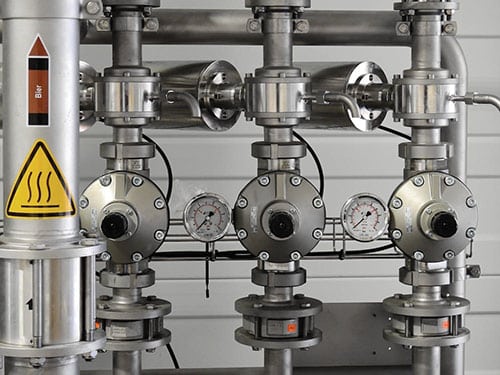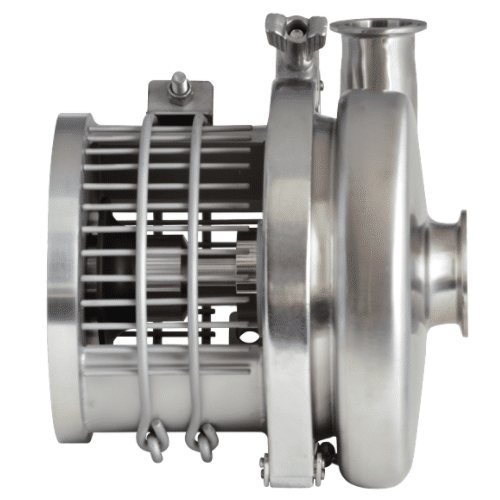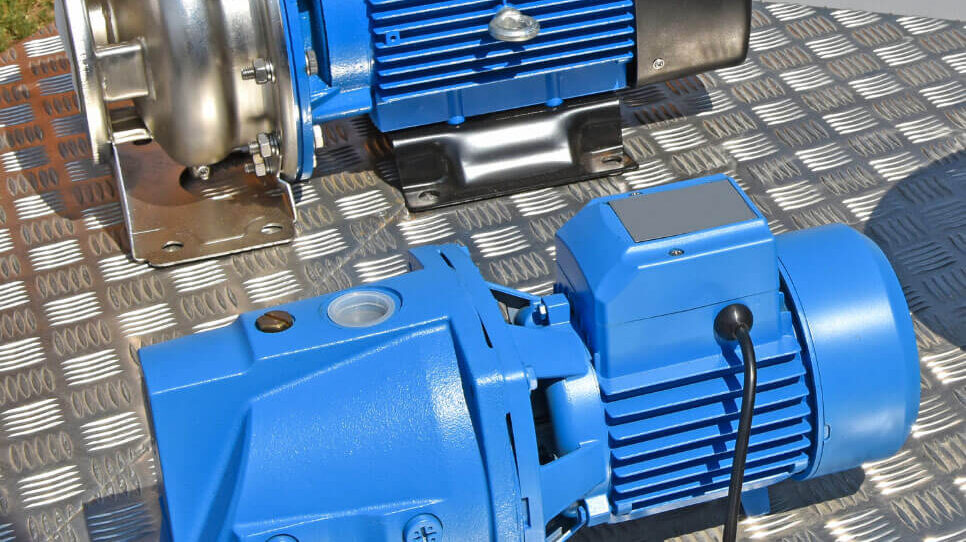Pump Head vs Pump Motor: 3 Intriguing Facts You Should Know
You may have come across the term “pump head,” or simply “head,” and “pump motor,” or “motor,” when trying to decide between different sanitary pumps.
The concept of head, in particular, is often confused or misunderstood when examining the characteristics of a pump.
Before going any further, you should know that the head is not one of the main parts of a pump. Indeed, pumps typically consist of two main parts, namely the motor and the pump itself.
However, while the pump head may not be a physical part of a pump, it’s still a measure of the pump’s power. The greater the pressure the pump can generate, the greater the head.
Ultimately, the head is the highest height a pump can raise fluid against gravity. Pump head is measured in meters of liquid column and simply denoted in meters (m) or feet (ft).
For example, if you run a pipe vertically from your pump’s discharge port and fluid is pumped up to 20 feet, then your pump has a 20-foot head. The higher the head, the higher the pump can lift water.
On the other hand, the pump motor is an electrical induction unit that converts electrical energy into mechanical energy.
In centrifugal pumps, the motor is responsible for generating the rotary movement of the pump shaft connected to the pump’s impeller. Without the motor’s driving force, the pump wouldn’t have the input energy it requires to generate pressure and propel fluid.
Pump motors are important because they determine how much fluid a pump can move and how much pressure it can generate. You’ll want to ensure you have a pump motor that’s strong enough to generate the required amount of pressure for your specific application.
The main difference between the motor and the pump is that while the motor converts electrical energy into mechanical energy, the pump transfers or propels the fluid. The table below identifies more differences between the pump and the motor.
| Motor | Pump |
| Electro-mechanical device | Hydro-mechanical device |
| Mainly classified into alternating current (AC) and direct current (DC) motors | Mainly classified into centrifugal and positive displacement pumps |
| Generates the rotation that’s the source of mechanical energy for the pump | Transfers the received mechanical energy into fluid and pressurizes the fluid to move |
Let’s look at some even more interesting facts about pump head and pump motors.
1 – Pump Head Is Sometimes Confused With Pressure

A few people use the terms head and pressure interchangeably, which can lead to confusion for anyone unfamiliar with them.
As we’ve already established, head determines how high a pump can lift water.
Pressure, on the other hand, is the force with which the pump pushes fluid. As pressure increases, the pump’s head rises until it reaches maximum head, also known as shut-off head. At this point, there is zero flow.
A key difference between pump head and pressure is that one parameter is fluid dependent and the other isn’t.
Head is fluid independent, which means that a pump will raise various fluids to the same height, even if they have different specific gravities (or relative densities). It doesn’t matter if the fluid is heavy sludge or clear water.
Pressure is fluid dependent, which means it’s affected by a fluid’s density.
For example, water has a specific gravity of 1, so the pump will display less pressure for water than it would for sludges or slurries at the same head. Since the relative densities of sludges or slurries can be 2 or 3 times higher than water, it’s clear that the same head can generate different pressures in fluids with different relative densities.
Another difference between pump head and pressure arises in how they’re calculated.
Precision instruments, known as manometers, are placed on the pump’s suction and delivery lines to indicate the differential pressure imposed between suction and discharge. Pressure can be read and recorded in units including:
- Pascals (Pa)
- Standard atmospheres (atm)
- Pounds per square inch (psi or Ib/in2)
- Bar (bar)
Conversely, pump head is determined by establishing the maximum height a pump can lift a fluid to, and is described in either meters or feet.
You can use an online pump head calculator to determine pump head in feet. To do so, you’ll need to enter the following details:
- Flow rate
- Static head
- Inside diameter
- Pipe length
2 – The Most Useful Measure of Pump Head Is Total Head

Total head refers to the difference in height between the head (sometimes called the discharge head) and the fluid level in the suction head.
The total head is a very useful measure because it can’t be increased by raising the level of a fluid in the suction tank.
Discharge head varies depending on suction level; higher suction levels result in a higher head, while a lower suction level results in a comparatively lower head.
Pump manufacturers typically report the total head since it’s independent of the fluid level in a suction tank. By reporting the total head, manufacturers don’t have to predict or make assumptions about the level or height of the fluid in your suction tank.
To calculate total head, simply subtract the suction head from the pump head (Total Head = Pump Head – Suction Head).
Slightly advanced formulas to calculate total head also exist. For example, (±) net static head + friction head = pump total dynamic head.

The net static head depicted in the formula above is the difference in height between the fluid level in the suction tank and the discharge tank.
Friction head describes the energy lost as a fluid moves through piping due to the friction between the fluid and its conduit’s internal surfaces. Friction head is also known as friction loss or head loss due to pipe friction.
Bonus Fact: Fluid flows at its maximum rate when the pump head is zero. In this case, the pump’s energy is entirely focused on moving the fluid and not lifting it, thus ensuring faster flow.
Conversely, a pump’s flow is zero at its maximum pump head. At this point, the pump is using its power to lift the fluid already in the system, so it can’t generate any pressure to generate flow.
Don’t keep your pump running at zero flow for long durations. It’ll get very hot as the energy it puts into the water produces heat, which can’t be dissipated without flow. Overheating will cause the pump to seize up and fail, leading to costly repairs or replacement.
3 – Your Pump Motor Can Overload if Care Isn’t Taken

Centrifugal pumps can experience pump overloading when the driving (or pump) motor draws excess current. When overloading happens, the motor consumes more power than usual, and it may even trip.
Some reasons why the pump motor might draw a high current and overload include:
- Misalignment between the pump and driver (motor): This is the main reason for pump damage and tripping. Misalignment damages the stuffing box and causes failure of the mechanical seal, as well as premature bearing failure.
- Bearing failure: Worn or damaged bearings are often caused by a lack of lubrication or the pump being operated outside its recommended temperature range. Both conditions cause misalignment and increase friction, which can lead to pump failure.
- Oversized impeller: A pump’s flow rate is proportional to the impeller’s diameter. This means that an oversized impeller will cause the pump to draw more power. Always check that the motor can adequately handle a new load before increasing impeller size.
- Higher pump speed or viscosity: Increased pump speed increases the current drawn. Similarly, higher fluid viscosity increases the required pump brake horsepower. Stick to your pump’s design-specific speed, and work within the pump’s temperature range (lower fluid temperatures lead to increased viscosity).
- Operating too far out on the head-capacity curve: To avoid putting too much strain on the pump motor, use a discharge valve to adjust the discharge flow until the pump operates at its best efficiency point (BEP).
How Does Sanitary Fittings Factor In?
When it comes to choosing the best sanitary pumps for your operation, you want the most appropriate pump for the application. This means you not only have to consider a pump motor’s horsepower, but also pay attention to details like total head and pressure rating.
You’ll want to deal with professionals who offer outstanding customer service. Nothing beats being given all the facts about the workings of a pump when you’re in need of something particular.
Like Tim from Dupont, you’ll find that Sanitary Fittings will more than meet your expectations.
“The parts received were exactly what we needed, and the delivery was faster than we expected! I’ll certainly be retaining your vendor information for future needs. Thanks again for all your assistance!”
Share on LinkedIn:


